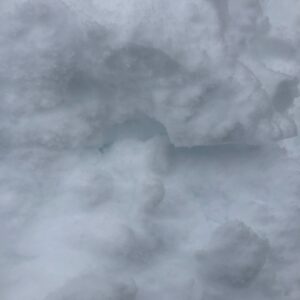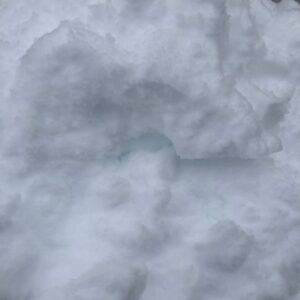This past winter I noticed a curious phenomenon while I was shovelling snow. I had seen the same thing once the previous winter as well: What appears to be blue snow!
The following photograph was taken on 25 December 2020 just before 11 am local time in St. Catharines, Ontario, where I currently live. I had been clearing my driveway of snow, throwing heavy shovels-full onto the side, when I noticed that the snow appeared blue where I had thrown it. Where the snow had already fallen, without being touched by me, it looked white; I could only see blue where I had just thrown the snow into piles.
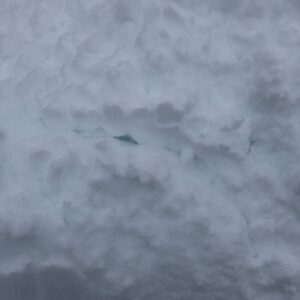
Can you see the blue coloring of the small gaps near the centre of the photograph above? It is faint in the photograph, but the coloring was quite striking in real life.
What causes the blue coloring, and why don’t I see this every time I shovel snow?
Snow has many different properties, depending on temperature, humidity, etc. When I shovel “dry” snow, it falls in heaps where I throw it at the side of the driveway. When I shovel snow that is optimally “wet,” it also falls in heaps where I throw it, but small “caverns” form where the snow rests. The formation of these “caverns” is a little unusual. If the snow is too dry, then caverns don’t form. If the snow is just wet enough, then there is enough “stickiness” so that the snow forms little arches above the small caverns.
I don’t fully understand the reason for why the insides of the snow caverns appear blue; for example, is it essential that the sky be overcast to see the blue colour? I don’t know the answer to this, because I don’t have enough experience with the phenomenon. But it seems clear to me that the basic mechanism behind the blue colour is scattering.
Why is the sky blue? The basic idea is that light from the Sun consists of all colours, but the air molecules in the atmosphere scatter light at the blue end of the spectrum much more efficiently than light at the red end. When we look at the sky we see light that has been scattered (the rest of the light goes straight on through, and never reaches our eyes), which is predominantly at the blue end of the spectrum, and this explains why the sky appears blue. The same thing must be the cause of the bluish colours in my little snow caverns: White light from the sky enters the little caverns, then gets scattered numerous times inside, thanks to the irregular placing of the snow crystals, and the light that emerges is a little bluer than the light that enters, because at each scattering a little more blue light is scattered than red light. The multiple scatterings is indeed a multiplier effect. At each scattering, plenty of light is absorbed instead of being scattered, which explains why the bluish light that emerges from the little caverns is so faint.
If you look at the Sun when it is very near the horizon (Carefully! Don’t hurt your eyes!) it appears red for the same reason; most of the light at the blue end of the spectrum has been scattered away, and what goes right on through to reach your eyes is light that is at the red end of the spectrum. Why doesn’t the Sun appear red when it is high in the sky? Consider the following figure. The black circle represents the circumference of the Earth, and the green circle represents the upper extent of the atmosphere. The blue dot at the top of the black circle represents your current position on the Earth. When the Sun is directly overhead, the Sun’s light has to travel through the atmosphere along the shortest distance between the green circle and the black circle; on the other hand, when the Sun is on the horizon, the Sun’s light has to travel through the atmosphere along the blue line segment. The way the circles have been drawn in the diagram, the distance the Sun’s light has to travel through the atmosphere at the horizon is six times the distance the Sun’s light has to travel through the atmosphere when it is directly overhead. But this is just the way I have drawn the circles, and is not true in reality. Correctly to scale, I should have drawn the diagram so that the thickness of the atmosphere is only about one-twentieth that shown here. However, had I done this, it would have been very difficult to see anything.
The thinner the gap between the two circles, the greater the ratio between the length of the blue line segment and the “overhead” line segment; thus, the relative reddening of the Sun when it is at the horizon compared to when it is overhead will be greater for “thinner” atmospheres.
The thickness of the atmosphere is not definite, because the atmosphere’s density gradually decreases as you move away from the Earth. However, one can take the effective thickness of the atmosphere to be that which includes a certain percentage of the mass of the atmosphere.
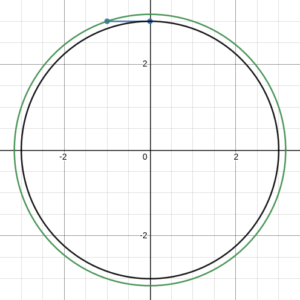
Other colourful phenomena depend on scattering. For example, a large body of water may appear blue for a reason similar to the reason that the sky appears blue. Light from the Sun penetrates into a large body of water and is scattered in all directions; water molecules are more effective at scattering light at the blue end of the spectrum than light at the red end of the spectrum, similarly to air molecules, and so large bodies of water tend to appear blue. A drinking glass full of water appears colourless, because there are so few water molecules in it that not much light scattering occurs. The scattering effect becomes more noticeable the larger the body of water is.
But not all large bodies of water appear blue, because they typically do not consist of pure water. If there is a lot of stirred up silt or mud in the water, then it may appear brown. If there are other substances in the water, then the colour may be different. Consider the beautiful bodies of water near Lake Louise in Alberta. For example, the Bow River’s source is Lake Louise, which is at the base of a glacier. The glacier grinds up rock as if flows down, and this powdered rock ends up in Lake Louise, and ultimately in the Bow River. The powdered rock scatters light most effectively at the green part of the spectrum, and the combined effect of light scattering from the water and from the rock powder can produce spectacular colours. Here is a photograph of Peyto Lake copied from Wikipedia:

By Chensiyuan – Own work, CC BY-SA 4.0, Link
The photographs hardly do justice to the spectacular river and lake colours in the Alberta Rockies. Here’s the Bow River near Canmore, again from Wikipedia:
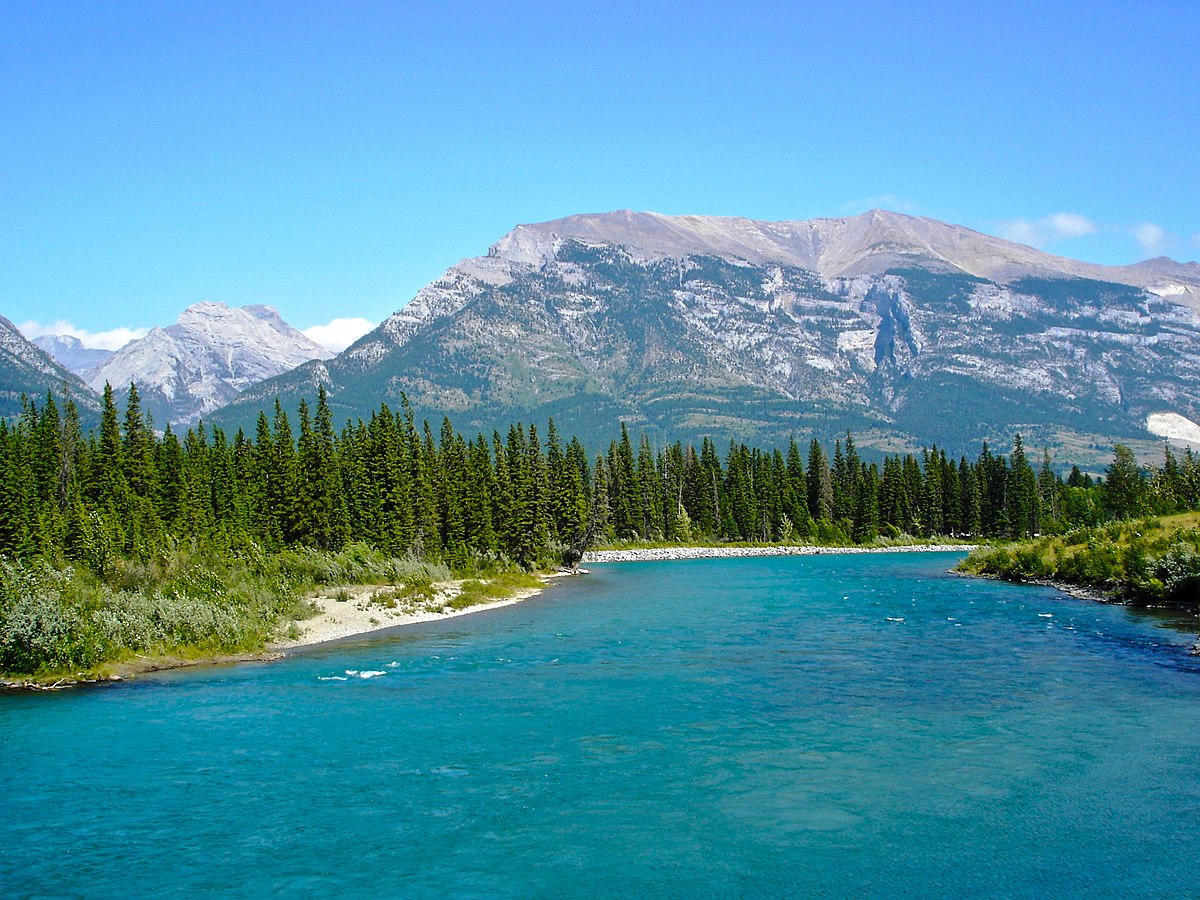
By Jack Borno, CC BY-SA 3.0, Link
Scattering is one important factor that causes colours. It would be interesting to discuss other causes of the colours we see around us in nature. I’ll have more to say about this in future posts.
It’s interesting to look at the beautiful world around us and take note of common causes; the same mechanism that causes the sky to be blue, and the Sun to appear redder at sunrise or sunset, and the beautiful Alberta rivers and lakes to have their spectacular colours, also caused the little caverns in the snow I was shovelling to appear blue. Neat!
Here are two other photographs of the blue coloring in my little snow caverns, taken at about the same time as the first photograph. In each of these photographs it is also difficult to see the blue colouring, as it is pretty faint. However, it is unmistakable in real life, and it is worth keeping your eyes peeled for this next winter.
